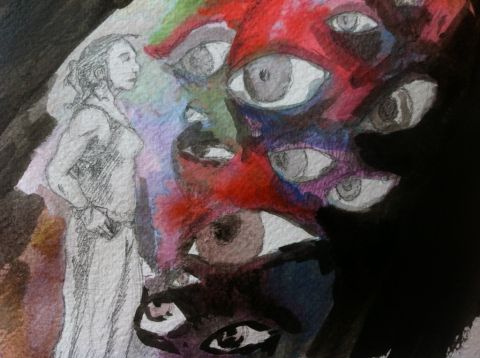In the first of four diary blogs, Tamarin Norwood guides us through her response to Paul Scott’s ‘Three Queens’……
1 – Before I watched the poem…
—
You only get one chance to encounter a poem for the first time. On my screen in front of me, in different windows, are the video of Paul’s poem, an interview with the poet and an outline of his own view of the poem. Which to look at first?
I’m invited to respond to the poem in some way, and Paul didn’t create the poem so that I could watch it as a non-signer. He didn’t create it so that the physical forms of his signs would pre-empt their meaning; he created it assuming the forms and meanings would reach the viewer together—just as a poets writing on the page assume the shapes and sounds of their words will reach the reader simultaneously with their meanings. (Such are my own assumptions about Paul’s assumptions anyway…) And from my own perspective I want to understand the poem and I know my level one BSL exam—passed three years ago and insufficiently practised ever since—won’t do much to help me understand the poem, let alone the intricate word play I know goes on in sign poetry.
Then again, I’m very interested both in the physical morphological form of BSL and in the state of being non-fluent in a language. I’ve been asked to respond to Paul’s poem as an artist, and much of my artwork draws on problems of linguistic fluency and comprehension. I’m interested to see how this kind of linguistic form can meet me given the inadequacy of my language. So although it will impoverish my first encounter I’m inclined to watch the video on its own and without any supporting information, then to supplement it with the texts later on.
Last year I went to see a Pina Bausch dance production and didn’t want to read the synopsis or any reviews in advance. A friend was appalled and told me I wouldn’t know what was going on. But I didn’t want to ‘know what was going on’. I wanted to enjoy the bodies and their movements exactly. I wanted to handle the raw material up close, and understand for myself what was happening. And when it came to it I was engrossed in the dance and the dancers from start to end, from the tips of their fingers and teeth to the footprints the light and sound seemed to absorb into curves. Afterwards there was much discussion over which character was which and what bit happened when. It sounded confused and unsatisfying after my thrilled experience of the event. Without a synopsis my understanding of the story was certainly impoverished, but it meant the dance was all I had, so I made it do everything. And so it did.
When I watch Paul’s movements, they will be language and not dance. I’m reminded of a reviewer’s insipid and ill-received remark that an ASL performance at New York’s Bowery had been ‘beautiful’. I don’t want to watch Paul’s movements unaccompanied by a written commentary so that I can aestheticize the form and find it ‘beautiful’, but so that I can appreciate as directly as I can the experience of encountering a new linguistic specimen and a new specimen of creative form while keeping the linguistic gap of my non-fluency in tact.
The problem is all the more complicated because of the linguistically unique form of sign languages, which sometimes make use of a kind of spatial onomatopoeia. Non-signers delight in guessing these meanings – often wildly and hilariously, but wrong or not the proximity of interpretation when I watch sign languages (not just BSL) feels different from the experience of hearing or reading unknown languages. These often erroneous interpretations cloud into the form as I watch, and mean I’m accumulating meanings despite myself.
With all this in mind—or perhaps trying to push all this out of mind—I’ll press play.
